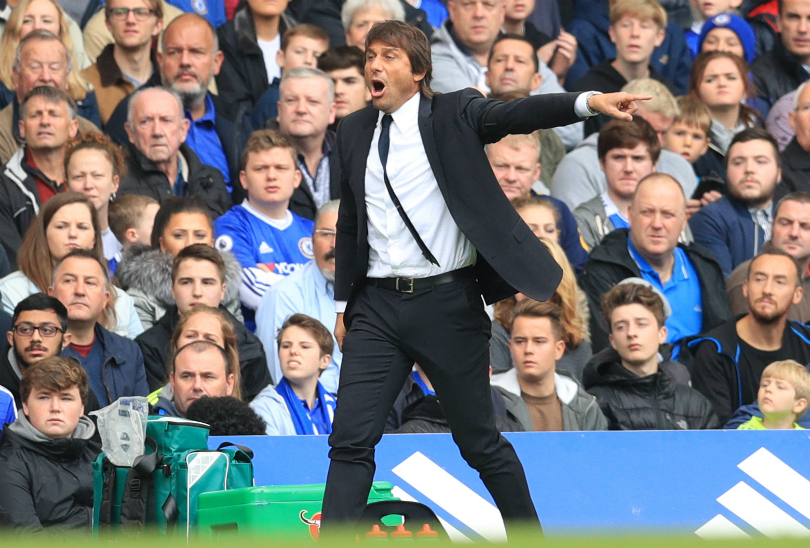Chelsea 3-0 Leicester: How Conte's 3-4-3 fits the Blues to a tee
Seb Stafford-Bloor analyses Chelsea's convincing 3-0 win over Leicester using Stats Zone

Another week, another formation tweak from Antonio Conte. Deploying Cesar Azpilicueta as his right-sided centre-half and Victor Moses and Marcos Alonso as the wing-back tandem, the Italian lined his side up in a 3-4-3.
This has been a season of false dawns for Chelsea, with promising new beginnings often giving way to the familiar dysfunction of 2015/16, but this, tentatively, might have been a tipping point.
Leicester City are in an odd place; still slightly drunk from May and lacking much of the intensity which propelled them to the title. Nevertheless, the way Chelsea brushed aside them at Stamford Bridge was impressive, as the hosts discovered the balance between width and pace that they have spent much of the season searching for.
True, they were gifted their two-nil lead in the first-half courtesy of some sleepy Leicester marking and, later, the visitors' inability to handle a routine Nemanja Matic through-ball, but there was still much to be impressed by.
Alonso and Moses were key, even if only because of their physical attributes. Left and right-footed players positioned on their natural sides, they provided the width which seems central to Conte's approach.

Both created long, diagonal passing options for Chelsea's centre-halves and they made runs to the byline: as a series of actions, neither were necessarily decisive to the game's outcome, but their movement stretched the pitch and opened space which the Leicester back-six struggled to fill. It's difficult to quantify that graphically, as it was the kind of influence which only really shows in the actions of others, but it was telling just how open Chelsea made the final-third of the pitch look.
Costa excels in all quarters
Get FourFourTwo Newsletter
The best features, fun and footballing quizzes, straight to your inbox every week.

Outside south-west London, Diego Costa is only newsworthy when his bad side emerges. If the red mist descends and the demons start to chatter in his ear, the world pays attention.
But on Saturday he showed his good side and provided another example of what a complete player he can be. Not "complete" in the sense of being a volatile balance of good and evil, but in a pure footballing context: he's as modern a forward as exists in the Premier League.
Costa's primary role is to change the score, but he's also key to Chelsea's ability to establish a mood in games
He opened the scoring, but was particularly prominent throughout the first-half. He was part battering-ram as normal, but also a reliable holding option for surrounding players (he received 11 passes from Eden Hazard, eight from N'Golo Kante, and five from Nemanja Matic).
Costa's primary role is to change the score, but he's also key to Chelsea's ability to establish a mood in games. His hassling of opposing centre-halves is a given, as is his tendency to carry the ball and drive beyond defenders, but it was the intelligence of his movement which allowed him to be as three-dimensionally impactful as he was this weekend.

Is Matic returning to his best?

Most Chelsea supporters would concede that Nemanja Matic has been off-colour for some time now and that, if big spending is permitted in January or the summer of 2017, he will be vulnerable. Not without cause: with the resilient N'Golo Kante now anchoring the midfield, the need for a second stabiliser does seem overly-cautious and appears to create a tactical speed-bump in Conte's formation. Matic's passing can be very formalaic and his heavy first-touch often delays the speed of play. Typically, he's more of full-stop or comma than an ellipsis.
Whether the result of his manager's instruction or simply an upturn in form, Saturday showed a significant improvement. Claudio Ranieri directed his press at Matic - or Kante - and the Serbian dealt with it extremely well.
Firstly in retaining possession and not losing the ball in areas which would have made his side vulnerable, but also in how rapidly he was able to push Chelsea's more advanced players into the Leicester half. Matic broke more lines than at any other point this season - even if his distribution wasn't strictly vertical, he appears to have broken the "retention for retention's sake" habit.

That he managed to find Eden Hazard (9) and Diego Costa (5) regularly was partly illustrative of Leicester's inability to properly restrict him but also - perhaps - of the tactical penny dropping.
Kante gets even better

Kante was brought to Stamford Bridge for his nullifying qualities and Chelsea parted with £30m for him to protect a defence which has become increasingly vulnerable in recent years. But, if a reminder of how rounded a midfielder he is was needed, his performance in the win over Leicester provided it.
By the 16th minute at Stamford Bridge, he had already retrieved possession four times. By full-time, he had won all four of his contested tackles and made five interceptions; nothing new there, that's what he does - but look beyond the obvious: he also made more passes in the attacking-third than any player other than Eden Hazard and started the move which led to Chelsea's third goal. This is the detail with Kante: he's obdurate and tenacious and warrants description with all sorts of similar terms, but he's an incredibly intelligent player in almost every respect.
To watch Kante live is to appreciate what a phenomenal athlete he is and to marvel over his ball-winning skills, but it's also to admire his extra layers: what covering those distances allows him to achieve and the effect he has on both sides of the ball.
Seb Stafford-Bloor is a football writer at Tifo Football and member of the Football Writers' Association. He was formerly a regularly columnist for the FourFourTwo website, covering all aspects of the game, including tactical analysis, reaction pieces, longer-term trends and critiquing the increasingly shady business of football's financial side and authorities' decision-making.

